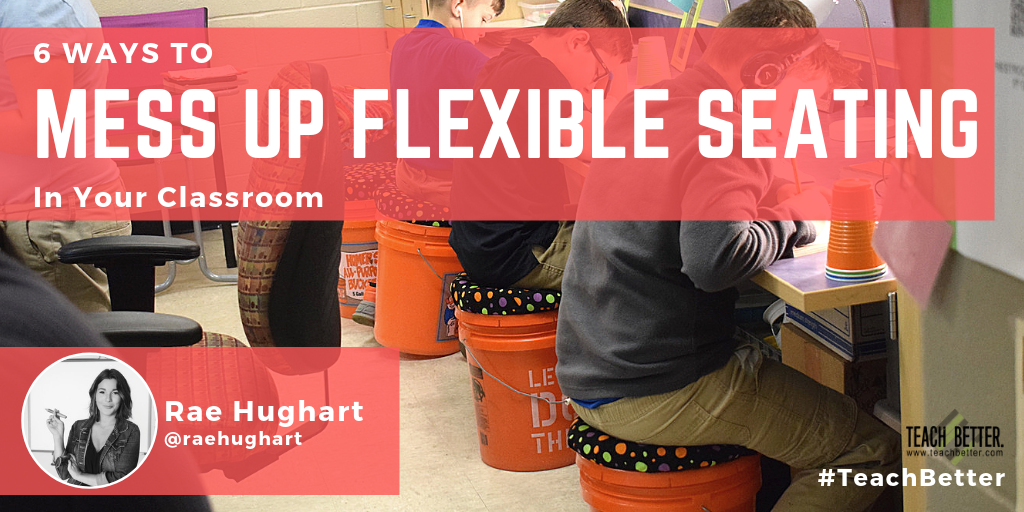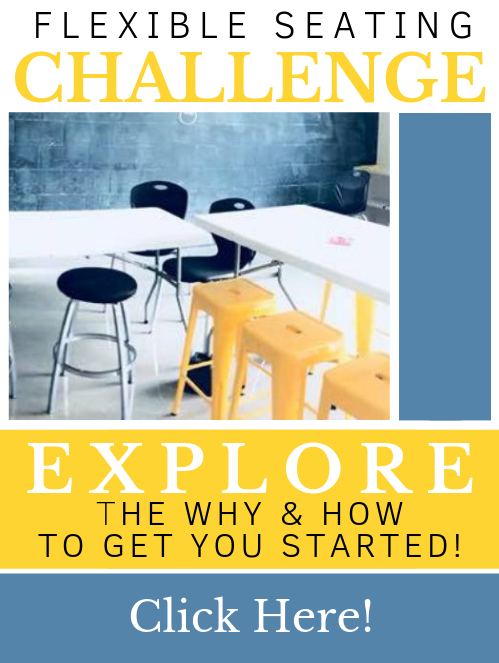Oh No! Don’t mess up your flexible seating game!
In This Post:
- Sometimes we can get too excited about a new initiative and jump in too quickly.
- Consider these 6 mistakes to avoid when implementing flexible seating in your classroom.
- Not having enough seats, focusing too much on quantity, and not communicating with stakeholders are just a few of the common mistakes we’ve seen with flexible seating.
- Let’s learn from each other and begin making better changes to enhance our students learning environments!
Let’s be honest, we have all been in a position when we were overly excited about a new project or initiative. So, we jump in, far too quickly, and do not consider the mistakes that may arise! While mistakes allow us to have some deep reflection, I’d still like to help you avoid as many as possible.
So let’s explore the top 6 ways to mess up flexible seating…and hope you don’t do any of them!
Mistake #1 : Not Having Enough Seats
When you explore flexible seating, you have to do it right! One way is to overlook the need for choice. Since flexible seating focuses on allowing students to have a choice in their seating options, you must plan ahead for all students to have a choice!
Imagine this – you have 34 total students. So, you purchase 34 flexible seating options. The first student comes in and makes a choice for a collaborative table seat. Student two walks in and chooses a comfy spot in the front corner of the classroom. As students file in, each student makes a choice dependent on their needs for that learning day. BUT, when the last few students come in… their options are severely limited!
When we do professional development with teachers on this topic, we get a common question, “Doesn’t this just show, students should come on time to class?” It’s important to remember the true idea of flexible seating. We don’t change our classrooms so students run from one class to another, hungry to find a place to learn. Rather, we change our classrooms to better suit our students’ needs. We want students to feel comfortable, eager to learn, and more focused. So, don’t make a choice to serve only most of your students – aim to serve them all.
The Solution : Adjust your flexible seating plan to accommodate 10 more students than your largest class. This way, no matter when students enter in the classroom, your space is conducive to supporting their needs!
Ask your students about their ideas. Share your ideas with your stakeholders. Then, build your plan from there! Click To TweetMistake #2 : Choosing Quantity Over Quality
I recognize the eagerness to jump into flexible seating is strong – but you want to do it right! When making the transition, many educators feel the need to cut corners and focus more on quantity. YES – we have a lot of students and we often want to make any flexible seating shift occur quickly in our classrooms. However, if you invest in poor quality, your resources will not hold up for your students. Then where will you be?
Therefore, consider the quality of your flexible seating tools. It is better to have a small section of your classroom offer students a flexible seating option as you begin to transform the room. Give yourself a little grace! Nothing done well can occur over night. Rather than a large classroom transformation filled with tools that don’t last through the week – broken stools (ouch), slanted tables (ick), popped pillows (ugh) – make your transition toward this new classroom style slow & steady. This mentality always wins the race.
[scroll down to keep reading]Mistake #3 : Not Having Procedures in Place
Students benefit from classroom routines and flexible seating is no different. When bringing new items into your classroom, students need to understand (1) how to use them, (2) what benefits they bring, (3) when they are appropriate, and (4) how to take care of them.
Do not limit your explanations to a 6 min mini lesson. Practice these policies with your students – not just once – but often. Even when you are 6 months into your flexible seating journey, throw in some review for your students. This will allow for consistency and appreciation for these new tools.
Your mission? Incorporate student ownership! Research shows students take better care of classroom tools they have ownership within. It may be your classroom, but it’s their learning space.
Mistake #4 : Not listening to Your Students
It is common for teachers to make a transition in their classroom with students in mind – but then forget to incorporate the students in to the details of implementation. Don’t just purchase what looks nice in your classroom Instagram feed. Instead, ask your students what their ideas are. Listen to their ideas. Then, with their recommendations and your expertise, make your room come to life!
Mistake #5 : Not Communicating With All Stakeholders
Do not forget about your stakeholders! They are just as much a part of your classroom as your students. I recognize we all have far more contact with the students in our classroom, than the other stakeholders in our world. However, all stakeholders matter!
So, keep them updated. One easy way to do this is through video updates. Using your phone, record two or three videos throughout the transformation to share what is new in your classroom, review procedures for your students, and highlight what problems are solved through your flexible seating transformation.
Mistake #6 : Paying Out of Pocket
Real Talk: Flexible Seating does not need to come out of your pocket money! You have more options! Explore donations, fundraisers, Donors Choose, Go Fund Me, garage sales – you name it, try it! Begin by brainstorming with your colleagues and Professional Learning Network. Ask your students about their ideas. Share your ideas with your stakeholders. Then, build your plan from there!
Don’t waste your time making these mistakes! Let’s learn from each other and begin making better changes to enhance our students learning environments!
About Rae Hughart
Rae Hughart is a Middle Level Math and Writing Educator in Illinois and the Director of Training and Development for Progressive Mastery Learning, LLC. In 2017, Rae was honored with the Illinois State University Outstanding Young Alumni Award – inducting her into the University Hall of Fame.




